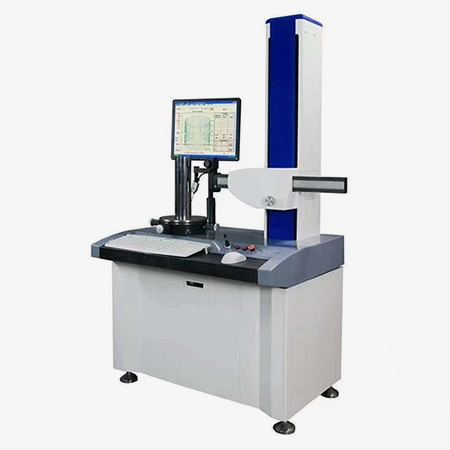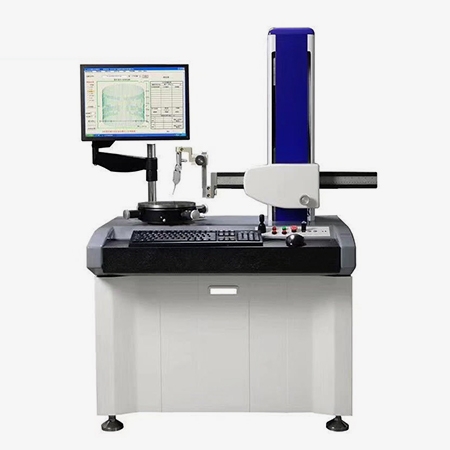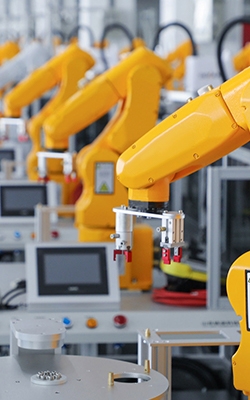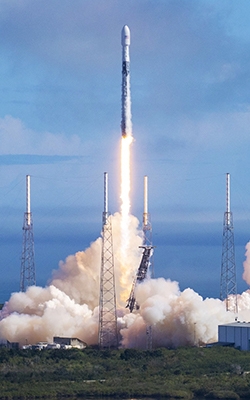The heavy-duty roundness cylindricity tester is a high-precision instrument designed for accurate measurements. It features a durable rotary air-bearing structure for long-lasting accuracy and reliability. Powered by user-friendly Windows-based CA software, it offers easy operation and versatile measurement functions. With advanced features like multi-data printing and automatic profile discontinuity recognition, this tester is ideal for precise measurements in industrial environments.

High Precision and Durability
- The cylindricity tester utilizes high-precision rotary air-bearing structure.
- The instrument is wear-resistant, maintains long-lasting accuracy, and has a long service life.
- The tester also has high accuracy and excellent stability.

Convenient Operation and Smart Features of Roundness Cylindricity Measuring Instrument
- Integrated structure, aesthetically pleasing, saves space in compact measurement rooms.
- CA measurement software based on the Windows system, easy to operate, with various measurement functions.
- Option to print a single or multiple measurement data on the same page.
- Automatic recognition of profile discontinuities and automatic exclusion function.
Application
The roundness cylindricity tester is crucial in industries like automotive, aerospace, machinery, precision instruments, and electronics. It ensures the accuracy of critical components such as engine parts, turbine blades, machine parts, and electronics, maintaining tight tolerances for optimal performance and safety. This tester plays a key role in ensuring product quality and longevity.

Automotive Industry

Electronics Industry

Machinery Manufacturing

Aerospace
| Model | SISCO-CT-CA35 | |
| Measurement Range | Max. Dia. | Φ400mm |
| Min. Inner Dia. | Φ5mm | |
| Max. Height | 550mm | |
| Spindle Accuracy | Radial Error | ±(0.025+5H/10000)μm |
| Axial Error | ±(0.025+6X/10000)μm | |
| Rotational Axis and Z-Axis Rail Parallelism | 2μm/400mm (Baseline reference) | |
| Workbench | Table Dia. | Φ220mm |
| Rotation Dia. | Φ400mm | |
| Load Wt. | 50kg | |
| Adjustment Range | Adjust the eccentricity ±2mm; adjust the level ±1° | |
| Rotation Speed | 0-12 rpm | |
| Column | Straightness (Narrow Range) | 0.5μm /100mm |
| Straightness (Wide Range) | 0.8μm /400mm | |
| Horizontal Arm | Horizontal Moving Distance | 180mm |
| Moving Speed | 0.5-6mm/s or manual | |
| Sensor | Range and Resolution | 500μm (radius difference); 0.005μm |
| Stylus Shape | φ2mm Gemstone Ball Probe (Other diameters available upon request) | |
| Installation Requirements | Power | 220-240V/110V AC, 50Hz, with separate ground |
| Compressed Air | Clean compressed air at 0.45–0.80Mpa pressure, consumption ≥ 0.2 m³/min | |
| Environmental Conditions | Operating temperature: 10°C–30°C (room temperature), humidity: 20-80% RH (without condensation), good grounding and no significant vibration sources | |
| Dimension | 985*650*1700mm | |
Q1: What is a roundness tester?
A1: A roundness tester is a precision measurement tool used to evaluate the roundness or circularity of a workpiece. It measures how closely a part conforms to a perfect circle by detecting deviations in its surface profile. The tester typically uses a high-precision probe that rotates around the part, collecting data to analyze any irregularities or deviations from ideal roundness. Roundness measuring machines are essential in industries such as automotive, aerospace, and precision manufacturing, where even the smallest deviations can impact the performance and quality of components like shafts, bearings, and gears. These testers help ensure that parts meet strict tolerances and maintain high levels of quality and functionality.
Q2: How does a roundness tester work?
A2: A roundness tester works by measuring the deviations of a workpiece's surface from a perfect circle. The part is placed on a rotating spindle, and a high-precision probe contacts the surface as the workpiece spins. The probe collects data points around the circumference, detecting any variations in radius. The tester’s software then analyzes this data, comparing it to an ideal circle, and calculates the roundness errors. These errors are displayed in numerical or graphical form, providing insights into the part’s quality and precision. The roundness measuring tool ensures that components meet stringent tolerances, critical for industries like automotive, aerospace, and precision manufacturing.
Q3: What is the difference between roundness tester and cylindricity tester?
A3: A roundness tester measures the deviation of a workpiece's surface from a perfect circle, focusing on assessing the roundness or circularity of a part along its circumference. It is primarily used to check the geometry of parts like shafts, bearings, and rings, ensuring they maintain consistent circularity. In contrast, a cylindricity tester measures the overall roundness and straightness of a cylindrical part, checking both its circularity and the straightness of its axis. While a roundness tester focuses solely on the cross-sectional shape, a cylindricity tester evaluates the entire geometry of the cylinder, including any deviations along the length of the part, ensuring that the part is both round and straight along its axis. Thus, cylindricity testing provides a more comprehensive analysis of a cylindrical part’s geometry, making it suitable for applications where both roundness and straightness are critical.
Tips: How to measure cylindricity using the cylindricity tester?
- Preparation: Ensure the cylindricity measuring equipmeny is properly calibrated and the workpiece is clean and free from any debris. Install the workpiece securely on the turntable or fixture, making sure it is centered and aligned.
- Measurement Setup: Select the appropriate measuring probe, typically a gemstone ball probe, and configure the measurement parameters on the system's software. The probe should be placed at the starting point of the workpiece.
- Rotation and Scanning: Rotate the workpiece slowly as the probe moves around the surface, scanning along different points of the circumference and axial direction. The software will record the probe's movement and measure deviations from perfect roundness.
- Data Analysis: Once the scan is complete, the system will generate a measurement profile showing any deviations from cylindricity. The software will analyze these deviations and display the results in terms of roundness, straightness, and other relevant parameters.
- Review and Adjustment: Review the results to identify any out-of-tolerance areas. If necessary, adjust the workpiece or make modifications to improve its cylindricity.
Thank you for buying industrial test and measurement equipment on SISCO.com, all products sold by SISCO and the partner cover a 12 months warranty, effective from the date of receiving the products.
What is covered?
SISCO is responsible for providing free spare parts, and free technical support to assist the customer to repair the defective products until the problem is solved.
What is not covered?
- Product purchased from anyone other than a SISCO store or a SISCO authorized reseller.
- Expendable parts.
- Routine cleaning or normal cosmetic and mechanical wear.
- Damage from misuse, abuse or neglect.
- Damage from use of parts other than SISCO approved.
- Damage from use outside the product’s usage or storage parameters.
- Damage from use of parts not sold by SISCO.
- Damage from modification or incorporation into other products.
- Damage from repair or replacement of warranted parts by a service provider other than a SISCO authorized service provider.
- Damage caused by the application environment not meeting the product usage requirements and the failure to perform preventive maintenance.

